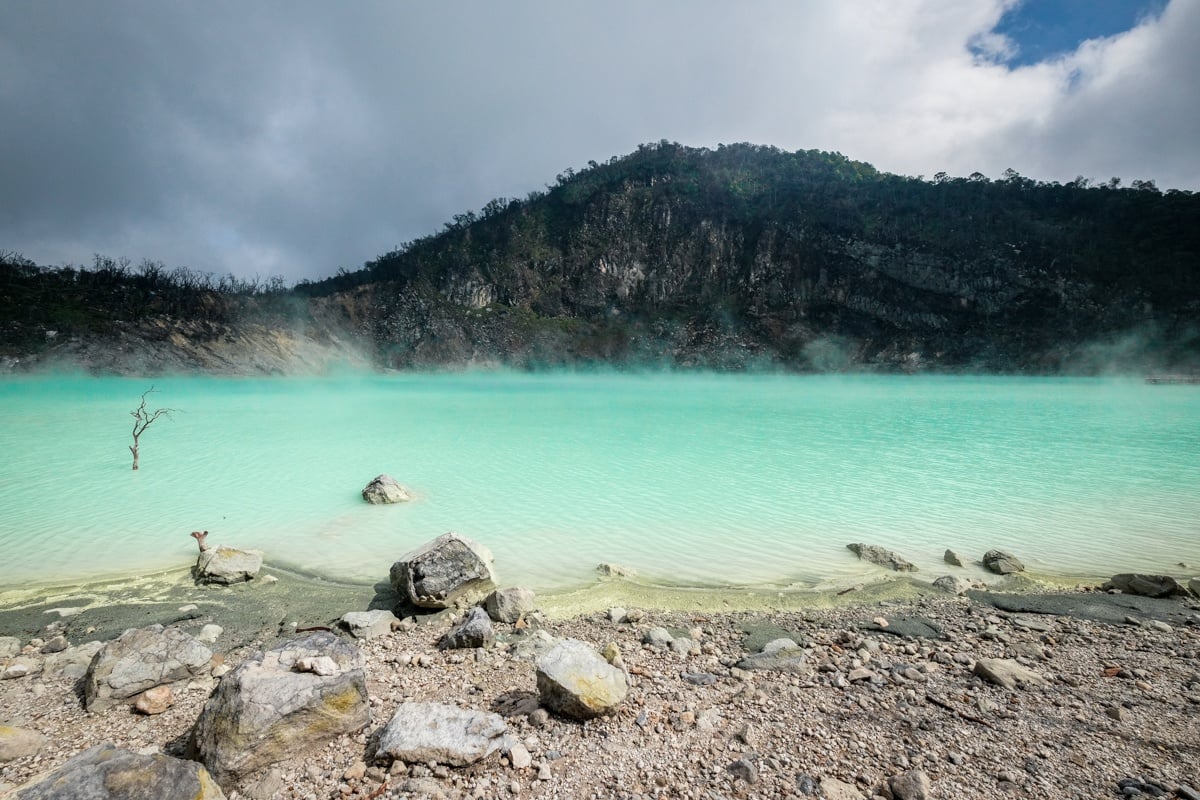Summary

Kawah Putih, situated in Ciwidey, a quaint village near Bandung, Indonesia, is a remarkable volcanic lake resulting from an eruption on Mount Patuha in the 11th century.
The term in Bahasa translates to ‘White Crater’, although its hue leans more towards turquoise, with the ability to transition to green, blue, or brown based on sulfur levels.
This crater lake stands out as one of the most extraordinary attractions in West Java, easily accessible for a day visit from the Bandung region.
This travel guide elucidates the route to Kawah Putih from Bandung, updated entrance fees, and essential information prior to your visit.
Table of Contents show

How To Get There
Kawah Putih is nestled in Ciwidey, a mountainous village approximately 50 km from Bandung in West Java, Indonesia. See GPS coordinates here.
Numerous international and domestic flights are available to Bandung airport (BDO), as it is one of Indonesia’s larger cities. There are even options to fly from Bali. You may explore flights to Bandung on Skyscanner.
Traveling from Bandung to Kawah Putih typically takes about 2 hours, factoring in traffic and the mountainous roads. You may either self-drive, or consider a guided tour or private driver for transportation (more details on that to follow).
Car vs Shuttle vs Hike
Upon reaching Kawah Putih, a shuttle bus is available to transport visitors for the final 5 km of the journey.
The cost for the shuttle is 27,000 Rupiah per person for a round trip, with buses operating every few minutes. Although the road may be in poor condition, the shuttle service is quite efficient.
If you prefer to take your vehicle directly to the final parking area, this is permissible at an additional fee of 150,000 Rupiah (~$10 USD) per vehicle, which may be considered costly.
Alternatively, hiking is an option; however, it involves a steep 5 km trek on a road that offers little in the way of scenery other than uninspiring pine trees.


Kawah Putih Bandung – What To Expect
Kawah Putih presents an enigmatic appearance, recognized for its sulfur-rich waters, leading to local legends of hauntings.
The contrast of dirty yellow sand, gnarled dead trees, and the ghostly surface of the lake contributes to an otherworldly ambiance.
Historically, the crater was mined for sulfur during the Dutch and later Japanese occupations (during World War II), with remnants of the tunnels still visible around the lake.
The lake itself offers a serene environment; however, the strong sulfur odor and harmful gases may limit your stay.

While this area can experience crowds from domestic tourists, the surrounding paths allow for personal space for capturing photographs.
For the adventurous, a pontoon is available for an additional fee of 10,000 Rupiah if one wishes to venture onto the lake.
This site is reminiscent of the ‘Blue Lagoon’ sulfur lake in Iceland; however, unlike that lagoon, swimming is not advisable due to the high acidity of Kawah Putih.
Overall, it is undoubtedly one of the most breathtaking destinations to experience in West Java!
Viewpoints
Bamboo ‘skywalk’ viewpoints are located on either side of the crater, offering elevated perspectives of the lake, with an additional fee of 10,000 Rupiah for access.
In my view, these extra viewpoints may not be particularly impressive, and the crater’s edges might be shrouded in clouds unless accessed at sunrise, which necessitates an early start.
Typically, the most remarkable views of the lake can be appreciated up close.
Is It Safe?
Kawah Putih is a stable and safe environment. Despite being a volcanic lake, no notable activity has been recorded since the 17th century.
Visitors are advised to limit their time at the lake to 15-30 minutes due to sulfur emissions, which is a prudent guideline to follow.
This location is not suitable for individuals with respiratory or cardiovascular conditions, pregnant women, or infants. If you do not fall within these categories, there is no need for concern.
However, the air quality may cause coughing or shortness of breath for some. Masks are available from vendors for 10,000 Rupiah near the entrance, which can offer some relief from the fumes.


What To Wear
The climate at the lake tends to be cool, located at an elevation of 2,430 meters (7,970 feet) above sea level, significantly higher than Bandung.
Temperatures can hover around 10 degrees Celsius (50 degrees Fahrenheit), so it is advisable to wear a jacket and long pants, especially during sunrise visits.
Kawah Putih Entrance Fee
- Foreigners:* 110,000 IDR (~$8 USD)
- Locals: 50,000 IDR
The entrance fee for Kawah Putih is set as of 2024; however, prices may fluctuate over time due to the site’s popularity among visitors from Bandung.
*Foreigners holding a KITAS/KITAP will be charged the local entrance fee for Kawah Putih.

Best Kawah Putih Tours
A highly-rated tour package for Kawah Putih is available through GetYourGuide, departing from Bandung, Indonesia.
This tour encompasses a visit to the Kawah Putih crater and includes hotel pickup/dropoff, entrance fees, parking fees, tolls, etc. Additionally, it includes stops at Rancabali Tea Plantation and Rancaupas Deer Conservation Center in the vicinity.
We have used GetYourGuide for numerous tours and activities worldwide and have consistently had positive experiences with them.
When To Visit
The optimal time to visit Kawah Putih is typically early morning, before the influx of domestic tourists arrives.
For photography enthusiasts, the lake provides excellent opportunities at any time of the day.
Where To Stay




More Things To See Nearby
Following your visit to Kawah Putih Bandung, numerous attractions await in the vicinity of Ciwidey.
This region hosts various hot springs and tea plantations, with the refreshing mountain climate likely encouraging extended stays.
Thank you for your interest! This travel guide to Kawah Putih aims to inform and inspire your adventure.
Your visit to this extraordinary white crater lake near Ciwidey will likely rank among the highlights of your time in Bandung, Indonesia.
For additional information, do explore my comprehensive Indonesia Travel Guide, featuring further tips, insights, and imagery!





